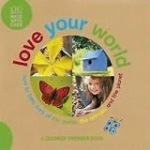
How time does fly – can’t believe that we’re celebrating our first grandbaby’s first birthday already! So I wanted to get Quinn something super special for this first milestone birthday of her little life. She is lucky to have two grandmas who are teachers (AKA getting lots of books!) and this grandma decided to make this gift all about cozying up with some good books to read. I happened upon this awesome little chair at @PotteryBarnKids and my gift idea was born! (I also found this darling little mouse doll for babies made by http://www.meiyaanddalvin.com to complete the package – even teething friendly!)

When I went book shopping, I discovered that one of my favorite children’s bookstores in Columbus is undergoing new ownership and is temporarily closed. What! I was so sad – Cover to Cover has been one of my favorite book spots going back to my college days. Change is SO hard! So off to Barnes & Nobles I went and I will say they have a pretty extensive board book collection for little ones. There’s so many books I want to introduce Quinn to over the years, but today I’m looking for board books that she can enjoy RIGHT NOW … ones just perfect for her little hands and interest. Here’s what I picked:
Little Yellow Bee: Garden Lift-a-Flap
Love little interactive books and Quinn does too! On each page, there’s an easy to open flap that shows the next animal in the garden. Short and sweet!
Dancing Feet by Lindsey Craig and Marc Brown

This book is so cute and really fun to read! Colorful, engaging collage illustrations. Simple text with fun words like thumpity, tippity, slappity, creepity, and stompity. Happy feet – a book to read and dance to!
The Very Hungry Caterpillar’s ABC by Eric Carle

I remember studying the characteristics of a good alphabet book back in college and one feature is that the picture for each letter should be clear and easy to locate. Some alphabet books are simply too busy! In this book, there is one animal on each page in Carle’s collage style and lots of white space. Another strong feature is the consistent placement of the letter and picture on each page. What makes this particular book unique is that the letters are all lower case. Hmmm … There’s a nice mixture of very familiar animals and unusual ones. What exactly is a quetzal?
Ten Pigs: An Epic Bath Adventure by Derek Anderson

I am so hoping that I haven’t already bought this book for Quinn – fingers crossed! This book is simply hilarious – a rarity in board books. It’s a counting book (number words) that begins with a happy pig sharing his bubble bath, perfect for me and you, with his rubber ducky. But along come his pig friends and all their water toys until the tub is beyond overflowing and pig is not happy at all! I won’t spoil the surprise ending, but it will have you laughing out loud! Very fun illustrations and rhyming text that will be fun to read aloud.
So there you have it! One cozy chair, four great books, and one happy first birthday!




















